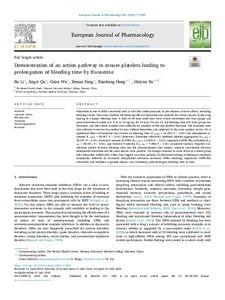Demonstration of an action pathway in mouse platelets leading to prolongation of bleeding time by fluoxetine
Hong Xiaohong; Fang Zeman; Xu Haiyun; Qu Jingsi; Li Ru; Wu Cairu
https://urn.fi/URN:NBN:fi-fe2022081154592
Tiivistelmä
Fluoxetine is one of SSRIs commonly used as first-line antidepressants. It also induces adverse effects, including bleeding events. This study clarified the bleeding effect of fluoxetine and explored the action cascade of this drug leading to a longer bleeding time. A total of 48 male adult mice were evenly distributed into four groups and given fluoxetine in saline at 0, 4, 8, or 16 mg/kg, for 14 days. On day 15, tail bleeding time of 6 mice/group was measured, and their blood samples were collected for analyses of relevant platelet functions. The remained mice were allowed to survive for another 14 days without fluoxetine, and subjected to the same analyses on day 29. A significant effect of fluoxetine was reveled on bleeding time (F (3,20) = 16.842, P < 0.01) and intraplatelet serotonin (F (3,20) = 90.967, P < 0.01). Moreover, fluoxetine effectively inhibited platelet aggregation (F(3,20) = 30.247, P < 0.01), decreased amount of GPIbα (F(3, 20) = 23.855, P < 0.01), suppressed GPIIb/IIIa activation (F(3,20) = 89.441, P < 0.01), and lowered P-selectin (F(3, 20) = 7.960, P < 0.01) on platelet surface. Negative correlations existed between bleeding time and the aforementioned four indices, whereas correlations between intraplatelet serotonin and the same indices were positive. All changes returned to same levels as Control group after fluoxetine withdrawal. These data suggest an action pathway of fluoxetine starting at binding to serotonin transporter, followed by decreased intraplatelet serotonin, increased GPIbα shedding, suppressed GPIIb/IIIa activation, and inhibited α-granule release, and concluding with prolonged bleeding time in mice.
Kokoelmat
- Rinnakkaistallenteet [19218]
